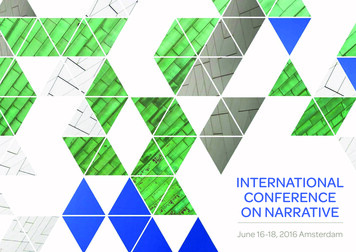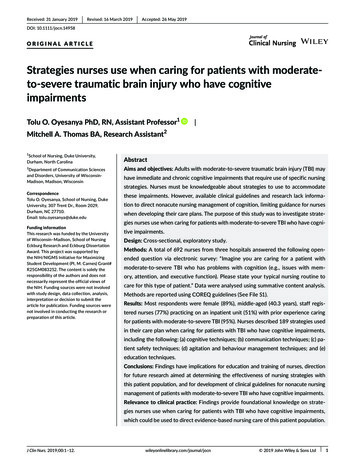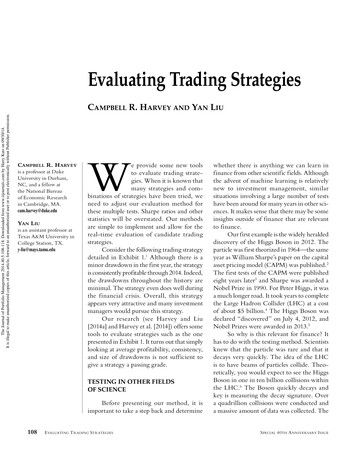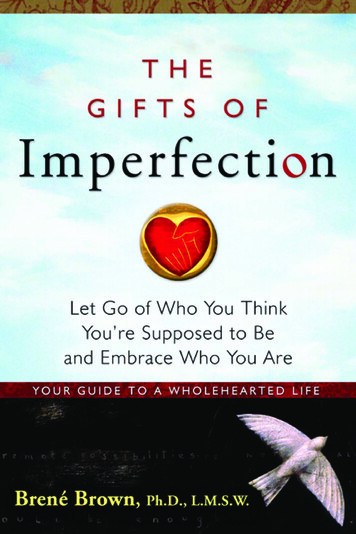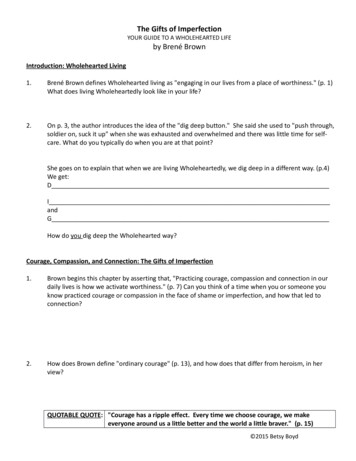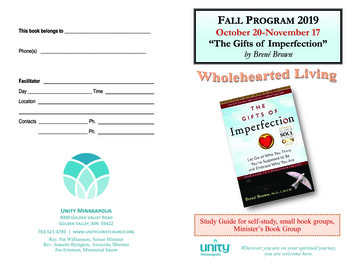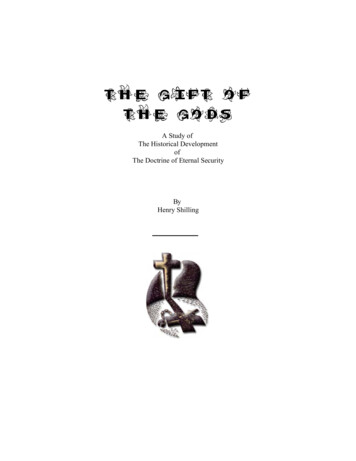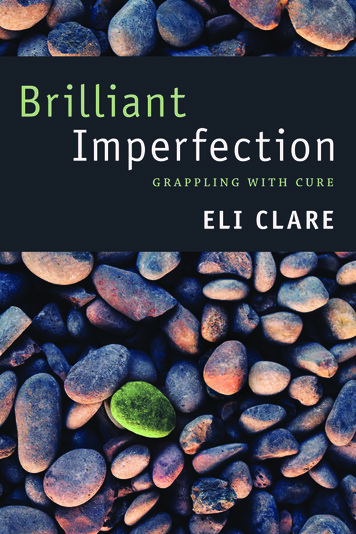
Transcription
BrilliantImperfectionGRAPPLING WITH CUREELI CLARE
BrilliantImperfectionGrappling with CureEli ClareDuke University Press Durham and London 2017
2017 Eli ClareAll rights reservedPrinted in the United States ofAmerica on acid- free paper Designed by Amy Ruth BuchananTypeset in Chaparral Pro andITC Officina Sans by CopperlineLibrary of Congress Cataloging- in- Publication DataNames: Clare, Eli, author.Title: Brilliant imperfection : grappling with cure /Eli Clare.Description: Durham : Duke University Press, 2017. Includes bibliographical references and index.Identifiers:lccn 2016030259 (print)lccn 2016031243 (ebook)isbn 9780822362760 (hardcover : alk. paper)isbn 9780822362876 (pbk. : alk. paper)isbn 9780822373520 (e- book)Subjects: lcsh: People with disabilities. Disabilities. Healing.Classification: lcc hv1568.c528 2017 (print) lcc hv1568(ebook) ddc 305.9/08 — dc23lc record available at https://lccn.loc.gov/2016030259
To the tallgrass prairieand the crip communitiesthat have sustained me.
ContentsAcknowledgments xiIntroduction: Writing a Mosaic xvA Note on Reading This Book:Thinking about Trigger Warnings xixBrilliant Imperfection: White Pines 11Ideology of CureBirth 5Prayers, Crystals, Vitamins 5Beliefs about Disability 7Overcoming Disability 8Hope in Motion 10Rebelling against Cure 12The Restoration of Health 14Walking in the Prairie 16Brilliant Imperfection: Twitches and Tremors 192Violence of CureDefect 23At the Center of Cure Lies Eradication 25
Personhood Is a Weapon 28Great Turmoil 30Brilliant Imperfection: Maples 333In Tandem with CureCerebral Palsy 37Reading Diagnosis 41Disorder 43Antibiotics and Acupuncture 44The Price of Diagnosis 45Useful, but to Whom? 48Brilliant Imperfection: Stone 494Nuances of CureWishing You Less Pain 53Wanting Cure 54Birthmark 54Cautionary Tale 55Body- Mind Yearning 57Yearning for the Peeper Pond 58Jostling My Anti- Cure Politics 60Your Suicide Haunts Me 63Brilliant Imperfection: Shells 655Structure of CureThe Medical- Industrial Complex 69A Far- Reaching Network 70Troubled and Troubling Body- Minds 71Variations on Cure 76Skin Lighteners and Hot Springs 77Brilliant Imperfection: Hermit Crabs 81
6How Cure WorksCure Just around the Corner 85Charity Events 88Shifting Technologies 91A Pharmaceutical History of Eflornithine 95Brilliant Imperfection: Rolling 997At the Center of CureCarrie Buck I: Yearning 103Carrie Buck II: Torrent of History 107Carrie Buck III: Feebleminded 110Lives Reduced to Case Files 112Living with Monkey 115Schizophrenia 119Brilliant Imperfection: Myrtle 1258Moving through CureChoosing Disability 129Airports and Cornfields 132Interdependence 135Wanting a Flat Chest 137Gender Identity Disorder 139Claiming Ourselves 142Brilliant Imperfection: Drag Queen 1479Impacts of CureEndless Questions 151Ashley’s Father 152Resisting Intelligence 156Feeling Broken 158Being Fixed 161Shame and Pride 163Brilliant Imperfection: Survival Notes 169
10 Promise of CureNormal and Natural 173Finding Wholeness 174Gender Transition 177Bullied 180A Maze of Contradictions 183Mama, What Will You Swear? 184Walking in the Prairie Again 186Brilliant Imperfection: Cycling 189Notes 191Bibliography 201Index 209
AcknowledgmentsIn different forms, earlier versions of the following pieces appeared in avariety of anthologies, journals, and periodicals:“Airports and Cornfields,” “Birthmark,” “Body- Mind Yearning,”“Cautionary Tale,” “Living with Monkey,” “Normal and Natural,”“The Restoration of Health,” “Walking in the Prairie,” “Walkingin the Prairie Again,” “Wanting Cure,” “Wishing You Less Pain,”and “Yearning for the Peeper Pond” in Material Ecocriticism“Ashley’s Father” in Tikkun“Cerebral Palsy” in Writing the Walls Down: A Convergence oflgbtq Voices“Carrie Buck I: Yearning,” “Carrie Buck II: Torrent of History,” and“Carrie Buck III: Feebleminded” in the Journal of Literary andCultural Disability Studies“Gender Transition” in The Transgender Studies Reader 2“Shame and Pride” in the Seattle Journal for Social JusticeSo many people contributed to this book I don’t know where to begin.Editor extraordinaire and my first reader for the last twenty- five years,Joe Kadi has listened, urged me along, edited and reedited, and keptme grounded since the very first moments of this project. Susan Burch
and I have met twice a month for more than two years, reading and supporting each other’s writing projects. With generosity and brilliance, shehas given me endless feedback, pushed, nudged, kept me accountable,and invited me to strengthen and clarify my ideas. Sebastian Margaret helped me develop all the central ideas in this book, supporting andencouraging me in countless ways. Mel Chen and Alison Kafer workshopped the manuscript at a crucial moment, helping me envision its final shape. My sweetie, Samuel Lurie, put up with me for the eleven- plusyears I’ve been working on this project, talking through ideas, bringingme treats, and holding me.Alison Kafer, Gabriel Arkels, Jade Brooks, Joe Kadi, Mel Chen, Michelle Jarman, Rebecca Widom, Samuel Lurie, Sebastian Margaret, Susan Burch, and Susan Raffo all read and listened to the manuscript invarious stages of disarray, contributing greatly to the finished book. Inaddition, the whole project was supported by dozens of people in dozensof ways. Some helped me clarify and focus my thinking; others pointedme in new directions; still others gave me a necessary nudge at the exactright moment. Among them are Alexander John Goodrum, Angela Carter, Annette Marcus, Aura Glaser, Aurora Levins Morales, Chris Bell, Corbett O’Toole, Cory Silverberg, Diana Courvant, Ellen Samuels, EunjungKim, Gloria Thomas, Karen Kerns, Kim Nielsen, Laura Hershey, LoreeErickson, Patricia Fontaine, Patty Berne, Robin Stephens, Sue Schweik,and Sunaura Taylor.I wrote this book as I sat in queer, trans, and disability communitiesand worked in multiracial, queer and trans people- of- color- led activistspaces. A big, big thank you for all the meetings, meals, walks/rolls, conversations, ideas, and aha moments to Aaron Ambrose, Alice Shepard,Amber Hollibaugh, Curtis Walker, Dean Spade, Denise Roy, Emi Koyama,Erick Fabris, Ethan Young, Heather MacAllister, Ibby Grace, Jake Pyne,Jay Sennett, Julio Orta, Laura Rauscher, Leah Dolmage, Leah LakshmiPiepzna- Samarasinha, Lenny Olin, Leroy Moore, Lezlie Frye, Lisa Weiner- Mahfuz, Margaret Price, Mia Mingus, Nirmala Erevelles, Owen Daniel- McCarter, Riva Lehrer, Susan Stinson, Syrus Ware, Toby MacNutt, andTrishala Deb. My activist home bases while I wrote—the Disability Justice Collective and the roots Collective—fed me in so many ways. A bigshout out to everyone in both of those groups.So much love, friendship, and encouragement makes my writingpossible. Many thanks to Adrianne Neff, Alison Kafer, Annette Marxii Acknowledgments
cus, Deirdre Kelly, Gabriel Arkels, Heba Nimr, Joe Kadi, Loree Erickson, Lynne Whitney, Mel Chen, Merri Rose, Patricia Fontaine, RebeccaWidom, Samuel Lurie, Sarah Paige, Sebastian Margaret, Susan Burch, Susan Cowling, Susan Raffo, and Tammie Johnson for all your sustenance.And finally, this book wouldn’t have happened without the time andspace I found at a residency at the Blue Mountain Center in the Adirondack Mountains and self- made writing retreats at Button Bay State Parkand Ricker Pond State Park, both in Vermont. Endless gratitude to thetrees and rocks, water and sky.Acknowledgmentsxiii
Introduction:Writing a MosaicMeandering through a working-class neighborhood in Chicago, I happenupon a mosaic spread across the front of a community center. The colorscatch me; purple, lavender, yellow, orange dance together. Up close the tilesare smooth, jagged, rounded, reflective, translucent, sparkling in the morning sun, no two pieces the same size and shape.When I set out to write about cure more than a decade ago, I didn’tintend to create a swirling, multibranched pattern of histories, ideas,and feelings. I planned to craft a half dozen interlocking essays. I imagined a simple, well- laid- out collage. But as so often happens with creativeprojects, I’ve ended up somewhere I never envisioned. I wrote a mosaic.The fragments and slivers that make up this book came to me in myfury about eugenic practices, the words defect and monkey, the destruction of tallgrass prairie. They took shape as more than one disabilityactivist challenged my fierce anti- cure politics. They emerged as I siftedthrough my own experiences with the diagnoses of mental retardation,cerebral palsy, schizophrenia, and gender identity disorder.Everything in this mosaic started as a conversation. I drew on disability politics, antiracist activism, queer and transgender movement building, fat liberation work. I pulled environmental justice and reproductivejustice into the fray. I used what I know firsthand about ableism and howit interlocks with racism, sexism, homophobia, transphobia, and classism.
I followed the lead of many communities and spiritual traditionsthat recognize body and mind not as two entities but as one, resisting the dualism built into white Western culture. Some use the wordbodymind or mindbody; others choose body/mind or body- and- mind. Isettled on body- mind in order to recognize both the inextricable relationships between our bodies and our minds and the ways in which theideology of cure operates as if the two are distinct — the mind superiorto the body, the mind defining personhood, the mind separating humansfrom nonhumans.I trail my fingers along the mosaic, feeling bumps and ridges, the tiles’rough edges, almost sharp. And then I step back to the curb. The individualshapes become less distinct, and a woman’s face, a boy in a handstand, feetakimbo, a hand holding a paintbrush emerge. They are vibrant, fractured,whole.I started to see the patterns among these seemingly disconnectedfragments and slivers as I talked late at night with friends hunkeredaround kitchen tables; watched the maple trees outside my writingroom, season after season; and slept outside, sheltered by white pines.But cure is slippery. Every place I began turned into a hundred newbeginnings. I uncovered cure in obvious places: the Muscular DystrophyAssociation’s fund- raising appeals, the rhetoric of actor and wheelchairuser Christopher Reeve as he lobbied for stem cell research and searchedfor a way to walk again. But it also kept appearing in less obvious places:ex- gay conversion therapy, weight loss surgery, and skin lighteningcreams marketed to dark- skinned women of color. I heard its echoesin ads for products claiming to remove women’s facial hair and felt itsreverberations in the medical technology some transgender people useto reshape our gendered and sexed body- minds. I saw it embedded inunderstandings of normal and abnormal, natural and unnatural, in stereo types about disabled and chronically ill people, in the ways racism castsBlack, Indigenous, and other people of color as defective. I slowly realized just how far the ideology of cure reaches.I couldn’t tell any one story without being interrupted by a half dozenothers. I landed inside a knot of contradictions. Cure saves lives; curemanipulates lives; cure prioritizes some lives over others; cure makesprofits; cure justifies violence; cure promises resolution to body- mindloss. I grappled through this tangle, picking up the same conundrumsxvi Introduction
and questions repeatedly, turning them over and over, placing them sideby side, creating patterns and dialogues.I’m drawn back to the mosaic later in the day, the bright yellows now lightbrowns in the afternoon shade. I stand again at the curb, admiring. At thisangle, I see spirals and stars, concentric circles of blue, a river of deep red.I could swear they weren’t here this morning.I wrote prose poems, diatribes, provocations, personal stories. I delvedinto history. I crafted political analysis. Cure kept shifting. No singlegenre was able to contain all these fragments. For a long time, I couldn’tenvision this book’s fractured wholeness.And then, brilliant imperfection emerged, swirling between my words.I learned this idea in disability community from my longtime friend andfierce activist Sebastian Margaret. As a way of knowing, understanding,and living with disability and chronic illness, brilliant imperfection isrooted in the nonnegotiable value of body- mind difference. It resists thepressures of normal and abnormal. It defies the easy splitting of naturalfrom unnatural. It has emerged from collective understandings and stubborn survivals. It is expressed in different ways by different communities. Sebastian taught it to me as an uppity, determined pride. Brilliantimperfection winds through this mosaic, a river of deep red.Inside these shifting yellows, these ridges and bumps, these trianglesand multisided oblongs, I’m still finding ideas, stories, and feelings thatprovoke me, surprise me, leave me wanting more.Standing at the curb, I know that the spirals and stars, concentric circles ofblue were here all along. They simply appeared because my angle changed.Come sit with me. Let this mosaic that began in conversation spark ahundred new conversations.Writing a Mosaicxvii
san Burch, and Susan Raffo all read and listened to the manuscript in various stages of disarray, contributing greatly to the finished book. . And then, brilliant imperfection emerged, swirling between my words. I learned this idea in disability community from
